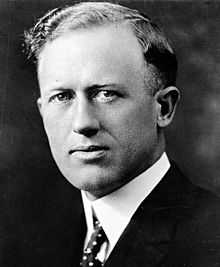Dan Moody
| Dan Moody | |
|---|---|
 | |
| 30th Governor of Texas | |
| In office January 17, 1927 – January 20, 1931 | |
| Lieutenant | Barry Miller |
| Preceded by | Miriam A. Ferguson |
| Succeeded by | Ross S. Sterling |
| Texas Attorney General | |
| In office January, 1925 – January, 1927 | |
| Preceded by | Walter Angus Keeling |
| Succeeded by | Claude Pollard |
| District Attorney Williamson County | |
| In office 1922–1925 | |
| Personal details | |
| Born | Daniel James Moody, Jr. June 1, 1893 Taylor, Texas |
| Died | May 22, 1966 (aged 72) Austin, Texas |
| Resting place | Texas State Cemetery |
| Political party | Democratic |
| Spouse(s) | Mildred Paxton Moody |
| Alma mater | University of Texas Law School |
| Profession | Attorney |
| Military service | |
| Service/branch | United States Army Texas National Guard |
| Rank | 2nd Lieutenant and Captain (Guard) 2nd Lieutenant (Army) |
| Battles/wars | World War I |
Daniel James Moody, Jr. (June 1, 1893 – May 22, 1966), was a Democratic political figure, originally from Taylor, Texas, USA. He served as the 30th Governor of Texas between 1927 and 1931. At the age of thirty-three, he was elected and took office as the youngest governor in Texas history.[1]
Family background and early life
Moody Jr. was born on June 1, 1893 in Taylor, Texas. He was the son of Taylor's mayor-justice of the peace-school board chairman Daniel James Moody Sr. who was one of the town's first settlers in 1876. His mother Nannie Elizabeth Robertson was a local school teacher when Moody Sr. married her in 1890. Moody Jr. was an alumnus of the University of Texas Law School, and became a member of the State Bar of Texas at the age of 21, in 1914, and began practicing with Harris Melasky in Taylor. During World War I, Moody served in both the Texas National Guard as first a 2nd Lieutenant and then Captain, and also the United States Army as a 2nd Lieutenant.[2]
Public service
In 1920, Moody Jr. served as Williamson County Attorney, a position he held for two years before becoming District Attorney in 1922. In 1923, Moody obtained an assault conviction against four members of the Ku Klux Klan for beating and tarring a white traveling salesman. At this time, the Klan was very powerful in Texas, with an estimated 150,000 members in the state, including the national "imperial wizard". Texas Klansmen included a U.S. senator and the mayors of Dallas, Fort Worth and Wichita Falls. This case was widely reported and gave him political momentum, despite Klan opposition.[3]
After election as Texas Attorney General in 1925, Moody Jr. conducted investigations of the highly corrupt James E. Ferguson, whose wife Miriam A. Ferguson was serving as the Governor of Texas. His investigation recovered $1 million for the taxpayers of Texas. In 1927, Moody defeated Ma Ferguson in a runoff election to become the youngest governor of Texas. A conservative Democrat, he served two terms as Governor before leaving public office. He supported a reform program of state prisons, roads and auditing system. In the 1930s he became a staunch critic of President Franklin Roosevelt's New Deal. He resumed private law practice in Austin, Texas after his last term as Governor. Moody was third in the 1942 Democratic primary for the U.S. Senate seat behind former Governors W. Lee O'Daniel and James Allred, won by O'Daniel. Moody represented Coke R. Stevenson in his case against Lyndon B. Johnson over the hotly contested 1948 Democratic Senatorial Second Primary electoral dispute, Allred represented Johnson.
By the 1950s he was still a Democrat, but endorsed Republican Dwight Eisenhower for president in 1952 and 1956 and Republican Richard Nixon for President in 1960.[4]
Personal life and final years
On April 20, 1926, he married Mildred Paxton of Abilene, Texas. The couple had two children.[5]
Governor and Mrs. Moody spent their remaining years in Austin. Dan Moody died in 1966 and was buried at the Texas State Cemetery.[6] Mildred outlived him by 17 years, dying in 1983. She is buried next to him.[7]
Williamson County Courthouse
The courtroom of the Williamson County Courthouse where Moody tried his famous case against the K.K.K. was completely restored to its 1920s appearance and was reopened in 2007. It is free and open to the public in Georgetown, Texas.
References
- ↑ "MOODY, DANIEL JAMES, JR.". Texas State Historical Association. Retrieved January 23, 2013.
- ↑ Michna, Irene K (2011). Taylor. Arcdia Publishing;. pp. 39, 40. ISBN 978-0-7385-8502-4.
- ↑ Paulsen, James W. (March 2012). Hunter, Michelle, ed. "Breaking the Back of the Texas Klan". Texas Bar Journal (Austin, TX: State Bar of Texas) 75 (9): 209.
- ↑ Texas Biographical Dictionary. Native Amer Books Distributor. 1996. p. 39. ISBN 978-0-403-09951-1.
- ↑ Fleming, Richard T. "Daniel Moody Jr.". Handbook of Texas Online. Texas State Historical Association. Retrieved 28 February 2012.
- ↑ Dan Moody at Find a Grave
- ↑ Mildred Paxton Moody at Find a Grave
External links
| Wikimedia Commons has media related to Dan Moody. |
- Governor Dan Moody Museum
- Dan Moody from the Handbook of Texas Online
- National Governors Association
- Texas State Historical Association
- Georgetown Press announcement of Ken Anderson book "Dan Moody: Crusader for Justice"
| Political offices | ||
|---|---|---|
| Preceded by Miriam A. Ferguson |
Governor of Texas January 17, 1927 – January 20, 1931 |
Succeeded by Ross S. Sterling |
| ||||||||||||

